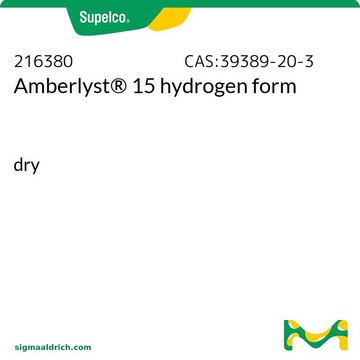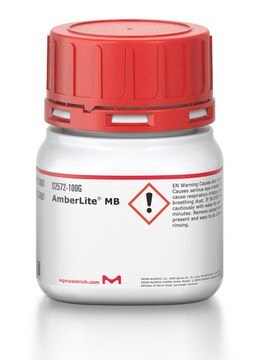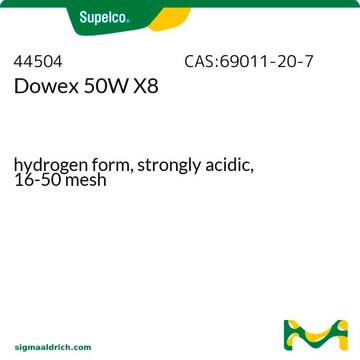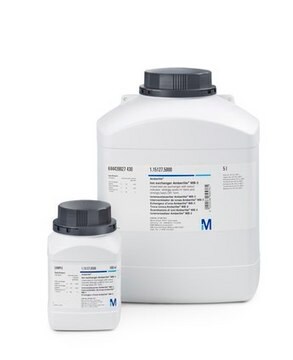436712
Amberlyst® 36 Ion Exchange Resin
16-50 mesh
About This Item
Empfohlene Produkte
Produktbezeichnung
Amberlyst® 36, total pore volume 0.20 mL/g
Form
beads
Qualitätsniveau
Quervernetzung
12 % cross-linked
Enthält
51-57% Moisture content (H+ form)
Zusammensetzung
water, 55%
Methode(n)
LPLC: suitable
Oberflächenbereich
33 m2/g
Matrix
styrene divinylbenzene (macroporous)
Aktive Matrixgruppe
sulfonic acid functional group
Partikelgröße
<0.425 mm (0.5% max)
0.600-0.850 mm (uniformity coefficient: <1.6)
>1.180 mm (4.0% max)
Porengröße
0.20 mL/g total pore volume
240 Å average pore diameter
Kapazität
>1.95 eq/L exchange capacity
>5.40 meq/g exchange capacity
Dichte
1.2 g/mL at 25 °C (lit.)
Trenntechnik
cation exchange
SMILES String
[S](=O)(=O)(O)c2c(cccc2)C=C.c1(c(cccc1)C=C)C=C
InChI
1S/C10H10.C8H8O3S/c1-3-9-7-5-6-8-10(9)4-2;1-2-7-5-3-4-6-8(7)12(9,10)11/h3-8H,1-2H2;2-6H,1H2,(H,9,10,11)
InChIKey
SIWVGXQOXWGJCI-UHFFFAOYSA-N
Verwandte Kategorien
Allgemeine Beschreibung
Wasser zu Phenol: 45%
Wasser bis trocken: 54%
Anwendung
- Synthesis of renewable diesel and jet fuel range alkanes using 2-methylfuran and cyclohexanone.: This study explores a method for producing renewable diesel and jet fuel from biomass-derived compounds using Amberlyst® 36 as a catalyst, highlighting its potential for sustainable fuel production (Sun et al., 2022).
- Kinetic Study on Esterification of Acetic Acid with Isopropyl Alcohol Catalyzed by Ion Exchange Resin.: The research investigates the kinetics of esterification reactions catalyzed by Amberlyst® 36, providing insights into its efficiency and applicability in producing esters used in various industrial applications (Liu et al., 2019).
- Pretreatment of bio-oil with ion exchange resin to improve fuel quality and reduce char during hydrodeoxygenation upgrading with Pt/C.: This paper discusses the use of Amberlyst® 36 in the pretreatment of bio-oil to enhance its quality as a precursor for sustainable fuel, demonstrating the resin′s effectiveness in removing impurities that affect fuel refinement processes (Oh et al., 2021).
- Hydrolysis of Lipid-Extracted Chlorella vulgaris by Simultaneous Use of Solid and Liquid Acids.: The study examines the hydrolysis of algae-derived lipids using a combination of Amberlyst® 36 and other acids, showcasing its potential to facilitate biofuel production from microalgae (Seon et al., 2019).
- Valorization of lignocellulosic fibres of paper waste into levulinic acid using solid and aqueous Brønsted acid.: This research demonstrates the role of Amberlyst® 36 in converting paper waste into valuable chemicals like levulinic acid, contributing to waste valorization and chemical recycling (Chen et al., 2018).
Rechtliche Hinweise
Lagerklassenschlüssel
11 - Combustible Solids
WGK
WGK 3
Flammpunkt (°F)
Not applicable
Flammpunkt (°C)
Not applicable
Persönliche Schutzausrüstung
dust mask type N95 (US), Eyeshields, Gloves
Hier finden Sie alle aktuellen Versionen:
Besitzen Sie dieses Produkt bereits?
In der Dokumentenbibliothek finden Sie die Dokumentation zu den Produkten, die Sie kürzlich erworben haben.
Kunden haben sich ebenfalls angesehen
Unser Team von Wissenschaftlern verfügt über Erfahrung in allen Forschungsbereichen einschließlich Life Science, Materialwissenschaften, chemischer Synthese, Chromatographie, Analytik und vielen mehr..
Setzen Sie sich mit dem technischen Dienst in Verbindung.









